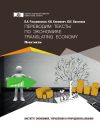
Автор книги: О. В. Иванов
Жанр: Бухучет; налогообложение; аудит, Бизнес-Книги
Возрастные ограничения: +12
сообщить о неприемлемом содержимом
Текущая страница: 4 (всего у книги 16 страниц) [доступный отрывок для чтения: 5 страниц]
Milton Friedman and Anna J. Schwartz, A Monetary History of the United States, 1867–1960 (1963); Bray Hammond, Banks and Politics in America from the Revolution to the Civil War (1957).
Stuart Bruchey
EXERCISES
Exercise 1. Words and expressions.
charter of incorporation – свидетельство о регистрации
Loan on real estate – ссуда под недвижимость
merchant banking houses – торговые банкирские дома
Pyramiding – финансовые пирамиды (многоступенчатое, многоярусное участие капитала одних компаний в финансовой системе других компаний)
wandering peddler
Cash reserves – резервы денежной наличности
wholesaler
Open Market Committee – Комитет открытого рынка, комитет по операциям на открытом рынке (в Федеральной резервной системе США)
retailer
Board of Governors – совет управляющих
create a deposit in the name of the borrower – оформлять вклад на имя ссудополучателя
Amount of reserves – сумма резервов
depreciated paper money – обесцененные деньги
Open market operations – операции на открытом рынке
bills of credit
Government securities – государственные ценные бумаги
Accommodation – зд. взаимные расчеты
Demand deposits – бессрочные вклады
Balance sheet
Interest rate – процентная ставка
Capital stock – основной капитал
Enact legislation – принимать законодательство
Authorized capital stock – уставный капитал
Federal Deposit Insurance Corporation – Федеральная корпорация по страхованию депозитов
Imposts – сборы
Call loan – ссуда до востребования
Redeem – осуществлять оплату
Demand deposit – бессрочный вклад
At par – по номиналу
Affiliate – филиал, отделение
Fiscal
Deposit banking – операции с депозитами
Monetary
Investment banking – операции с инвестициями
Downward drift – тенденция к снижению
Secure a loan – предоставлять обеспечение по ссуде
Commodities
Federal Reserve Board – Федеральное резервное управление
Surge – подъем
Divorce from – отделиться от
To divorce government from the banking system
Security firm – фирма, ведущая операции с ценными бумагами
To take out federal charter – получать федеральную регистрацию
Securities – ценные бумаги
Paid-in capital stock – оплаченная часть акционерного капитала
Partner – компаньон
Deposit liabilities – обязательства по вкладам
Stocks and bonds – акции и облигации
Prohibitive tax – запретительный (высокий) налог
Savings and loan institutions – ссудо-сберегательные учреждения
Apportion – пропорционально распределять
Fraud – подделка, мошенничество
Issue bank notes – пускать в обращение банкноты
Mismanagement – плохое управление
Credit instruments – кредитные документы
Deposit insurance – страхование вкладов
Exercise 2. Answer the questions.
1. What were the sources of money in America in the colonial period? 2. Can you describe the chain of credit in the early history of the United States? 3. What was the primary function of U.S. early commercial banks? 4. How did commercial banks give loans? 5. Why in early time political leaders in America were afraid of establishing quasi-governmental commercial banks in each state? 6. Why did Congress decide to charter a second BUS? 7. Did second BUS help to solve problems in banking? 8. What happened when the government stopped depositing funds in the BUS? 9. How did national banks emerge in the 19th century? 10. How were national banks formed in mid-19th century? 11. What requirements to bank reserves were applied to national banks? 12. What was the reason for Congress to pass the Federal Reserve Act in December 1913? 13. What changes has the Federal Reserve Act brought into the banking system? 14. What is the task of the Open Market Committee? 15. What techniques do Federal Reserve banks use to encourage or discourage loan expansion? 16. What was the essence of Glass-Steagall Banking Act of 1933?
Exercise 3. Translate into English.
1. В конце 18 в. первый коммерческий банк Америки получил свидетельство о регистрации. 2. Британские торговые банкирские дома давали краткосрочные кредиты оптовикам, которые в свою очередь кредитовали городских и сельских розничных торговцев – магазины и бродячих торговцев. 3. Конгресс зарегистрировал Банк Северной Америки по распоряжению Роберта Морриса. 4. Так как банкноты представляли собой обязательства о выплате звонкой монетой по требованию предъявителя, то банки должны были иметь соответствующие резервы, чтобы это делать. 5. Балансовые отчеты того времени свидетельствуют в целом о значительном успехе в сохранении необходимого уровня валютных резервов; отношение суммы находящихся в обращении банкнот к золотовалютным запасам было незначительным. 6. К находящимся в обращении банкнотам в разных местах применялся разный дисконт, а так как правительство вынуждено было принимать их для уплаты налогов и сборов, то государственных финансах наступил беспорядок, представляющий угрозу для деятельности правительства. 7. Такая угроза заставила банки штатов удерживать займы и дисконты в определенных пределах, что в свою очередь, позволяло им осуществлять оплату по своим обязательствам в «звонкой монете» по номиналу. 8. Однако банк не смог добиться одинакового успеха в выполнении фискальных и денежно-кредитных функций. 9. Политика сдерживания кредитования ради стабильности денежных средств была неправильной для того времени. 10. Национальные банки должны были покупать правительственные облигации на сумму, составляющую 1/3 оплаченного акционерного капитала. 11. Еще один серьезный недостаток явился следствием финансовых пирамид в национальных банках Нью-Йорк Сити, но еще более важным являлась неспособность предпринять что-либо в отношении периодической нехватки наличности и кредитов. 12. Сумма резервов может колебаться: для федеральных резервных сити-банков – от 10 до 22 % суммы бессрочных вкладов, а для «остальных» банков – от 7 до 14 %. 13. Более деликатными являются два других метода, которые имеются в распоряжении федерального резервного банка. 14. Один из методов, известный как «операции на открытом рынке», включает покупку или продажу государственных ценных бумаг руководителем Комитета по операциям на открытом рынке данной системы. 15. Покупка государственных ценных бумаг автоматически увеличивает, а продажа – уменьшает резервы банков-членов, позволяя таким образом соответственно расширять или сокращать кредитование. 16. Другой метод заключается в изменении процентной ставки на кредиты и ссуды, предоставляемые федеральными резервными банками банкам-членам. 17.Своими нынешними полномочиями Федеральная резервная система во многом обязана законодательству, принятому в ответ на неспособность системы предотвратить повсеместный крах банков в первые годы Великой Депрессии. 18. Закон также расширял полномочия двенадцати окружных федеральных резервных банков по контролю за суммой кредитов, предоставляемых своим членам, и запрещал выплачивать проценты по бессрочным вкладам, чтобы не поощрять периферийные банки направлять значительные суммы в Нью-Йорк, где они могли подпитывать спекуляцию ценными бумагами. 19. Закон наделял Федеральное резервное управление регулировать предоставление кредитов под обеспечение в виде акций и облигаций. 20. Компаньонам и руководителям фирм, ведущих операции с ценными бумагами, запрещалось работать директорами и служащими коммерческих банков. 21. Массовые банкротства ссудо-сберегающих учреждений страны в конце 1980-х выявили недостатки в федеральном страховании вкладов, что требовало как значительной помощи в размере более 150 млрд. долларов, так и осуществления структурных изменений в программе страхования.
Text 8. Bank of the United States
The Bank of the United States was established in 1791 to serve as a repository for federal funds and as the government’s fiscal agent. Initially proposed by Alexander Hamilton, the First Bank was granted a twenty-year charter by Congress in spite of the opposition of the Jeffersonians to whom it represented the dominance of mercantile over agrarian interests and an unconstitutional use of federal power. The Bank, based in Philadelphia with branches in eight cities, conducted general commercial business as well as acting for the government. It was both well managed and profitable, but it won the enmity of entrepreneurs and state banks, who argued that its fiscal caution was constraining economic development. Others were troubled by the fact that two-thirds of the bank stock was held by British interests. These critics, working with agrarian opponents of the bank, succeeded in preventing renewal of the charter in 1811, and the First Bank went out of operation.
Soon, however, problems associated with the financing of the War of 1812 led to a revival of interest in a central bank, and in 1816, the Second Bank of the United States was established, with functions very much like the first. The Second Bank’s initial years were difficult, and many felt that its mismanagement helped bring on the panic of 1819. Popular resentment led to efforts by several states to restrict the Bank’s operations, but in McCulloch v. Maryland (1819), the Supreme Court held that the Constitution had granted Congress the implied power to create a central bank and that the states could not legitimately constrain that power.
This decision did not settle the controversy, however. State banks and western entrepreneurs continued to criticize the Bank as an instrument of federal control and of eastern commercial interests. In 1832, Senator Henry Clay, a longtime supporter of the Bank, was running for president against Andrew Jackson, who was up for reelection. Clay persuaded the Bank’s president, Nicholas Biddle, to apply early for rechartering, thus injecting the issue into the campaign. Congress approved the renewal, but Jackson (who distrusted banks) vetoed it, campaigned on the issue, and took his electoral victory as a mandate for action. Starting in 1833, he removed all federal funds from the Bank. When its charter expired in 1836, the Second Bank ended its operations as a national institution. It was reestablished as a commercial bank under the laws of Pennsylvania, where it continued to operate until its failure in 1841.
EXERCISES
Exercise 1. Answer the questions:
1. What was the purpose of establishing the Bank of the United States and why was it opposed by the Jeffersonians? 2. What was the attitude of entrepreneurs and state banks to the First Bank? 3. What was the fate of the First Bank? 4. Against what political background was the Second Bank established? 5. What happened to the Second Bank and was it a success?
Text 9. Bank lending
Loans are among the highest-yielding assets a bank can add to its portfolio, and they provide the largest portion of operating revenue. That is why granting credits to qualified borrowers is the principal economic function of banks. For most banks in the United States, loans account for half or more of their total assets and about two-thirds of their revenues. Moreover, risk in banking tends to be concentrated in the loan portfolio. When a bank gets into serious financial trouble, its problems usually spring from significant amounts of loans that have become uncollectible due to mismanagement, illegal manipulation of loans, misguided lending policy, or from an unexpected economic downturn. No wonder, then, that when examiners appear at a bank they make a thorough review of the bank’s loan portfolio. Usually this involves a detailed analysis of the documentation and collateral for the largest loans, a review of a sample of small loans, and an evaluation of the bank’s loan policy to ensure that it is sound and prudent in order to protect the public’s funds.
One of the most difficult tasks in lending to business firms is deciding how to price the loan. The rate of interest at which a loan is raised may be thought of as the «price» of borrowing money. The lender wants to charge a high enough rate to ensure that each loan will be profitable and compensate the bank for the risk involved. However, the loan rate must also be low enough to accommodate the business customer in such a way that he or she can successfully repay the loan and not be driven away to another lender or into the open market for credit.
The traditional method of providing funds is the granting of overdrafts. With the overdraft facility, a company opens an account with the bank, and an overdraft with a specified limit is granted on the account. The overdraft is by far the cheapest form of borrowing, but it can only be obtained if the bank manager considers the customers to be creditworthy. Before agreeing practically any loan, a bank asks for some security, i.e. a kind of insurance. Thus a perfect advance is not only profitable and liquid, it is safe too. Many business loans are of such large denomination that the bank itself is at risk if the loan goes bad. Banks need to take special care, particularly, with business loans because they often carry large risk exposure. Moreover, it doesn’t take many business loans defaults to create bank earnings losses instead of profits. Most loan officers like to build several layers of protection around a business loan agreement to ensure the return of interest earnings to the bank. – Typically, this requires finding two or three sources of funds which the business borrower could draw upon to support the loan which may be the following: the borrower’s profits; assets pledged as collateral behind the loan; a strong balance sheet with ample amounts of marketable assets and net worth; guarantees given by the borrower, such as drawing on personal property.
Banks provide credits to a wide variety of customers and for many different purposes.
Banks make loans of reserves to other banks through the federal funds market and to securities dealers through repurchase agreements. Far more important in dollar volume, however, are direct loans to both businesses and individuals. These loans arise from negotiation between the bank and its customer and result in a written agreement designed to meet the specific credit needs of the customer and the requirements of the bank for adequate security and income.
Most bank credit is extended to commercial and industrial customers. Historically, commercial banks have preferred to make short-term loans to businesses, principally to support purchases of inventory. In recent years, however, banks have lengthened the maturity of their business loans to include term loans (which have maturities over one year) to finance the purchase of buildings machinery, and equipment. Because the longer-term loans carry greater risk due to unexpected changes in interest rates, banks have also required a much greater proportion of new loans to carry variable interest rates that can be changed in response to shifting market conditions. I»
Moreover, longer-term loans to business firms have been supplanted to some extent in recent years by equipment leasing plans available from larger banks and the subsidiaries of bank holding companies. These leases are the functional equivalent of a loan: the customer not only makes the required lease payments for using the equipment but is responsible for repairs and maintenance and for any taxes due. Lease financing carries not only significant cost and tax advantages for the customer but also substantial tax advantages for a bank because it can depreciate leased equipment.
Commercial banks are also important lenders in the real estate field, supporting the construction of residential and commercial structures. Major types of loans in the real estate category include farm real estate credit, residential loans, and mortgage loans on nonfarm commercial properties. Indeed, commercial banks are the most important source of construction financing in the economy.
NOTES
repurchase agreement (RP) – соглашение о покупке ценных бумаг с последующим выкупом по обусловленной цене
VOCABULARY NOTES
1. loan
bank loan – банковская ссуда syn. advance
to allow a loan – разрешить выдачу кредита, предоставлять ссуду
to agree a loan – заключать соглашения о займе syn. to negotiate a loan,
to extend a loan – предоставить ссуду syn. to make a loan,
to meet a loan – погашать ссуду syn. to repay a loan
a loan goes bad – ссуда не может быть погашена в срок
loans account for … – заемные средства составляют…
loan to individual – ссуда частному лицу
business loan – ссуда деловым предприятиям
short-term loan – краткосрочная ссуда
long-term loan – долгосрочная ссуда
farm loan – ссуда сельскохозяйственным предприятиям
installment loan – ссуда с погашением в рассрочку
term loans – (ам.) срочные ссуды
mortgage loan – ссуда под недвижимость syn. real estate loan
uncollectible loan – ссуда, которая не может быть погашена
loan interest – процент по займу syn. loan rate
loan policy – кредитная политика
loan officer – работник отдела кредитования
loan agreement – договор о ссуде, контракт на получение кредита
2. credit
to provide a credit – предоставить кредит syn. to extend a credit,
to obtain a credit – получить кредит
to meet credit needs – удовлетворить потребности в кредите
credit arrangement – предоставление кредита
to be creditworthy – быть кредитоспособным, платежеспособным
3. overdraft
overdraft facility – возможность овердрафта, право на превышение кредита
to grant an overdraft – предоставить право превысить кредит
to obtain an overdraft – получить право превысить кредит
to repay an overdraft – погасить задолженность банку
4. collateral
to serve as a collateral – служить обеспечением syn. to serve as a security
to pledge smth as a collateral behind a loan – заложить что-либо в качестве обеспечения по ссуде
5. security
against security – под обеспечение, под гарантию
to provide security – предоставить обеспечение предоставить обеспечение по ссуде syn. tо support a loan to back up a loan
6. lend
to lend on collateral – ссужать под залог
to lend to business – предоставлять ссуду деловому предприятию
to lend long – предоставить долгосрочную ссуду
lending policy – политика кредитования
lending (institutional) agency – кредитное учреждение
lending limits – кредитный максимум
lender – кредитор
7. borrow
to borrow short – получать краткосрочную ссуду
borrower – заемщик
bank borrowing – банковский заем
forms of borrowing – виды (полученных) займов
borrowing needs – потребности в займах (в заемных средствах)
8. portfolio
to add to the portfolio – увеличить портфель
loan portfolio – портфель выданных (банком) займов, общая сумма дебиторской задолженности
to make a review of the bank’s loan portfolio – провести проверку (анализ) всей дебиторской задолженности банка
9. finance
to finance smth – финансировать что-либо
construction financing – финансирование строительства
10. maturity
to lengthen the maturity – продлить срок погашения займа of loans
to have a maturity over … – иметь срок погашения более…
at maturity – по наступлении срока
long maturity – долгий срок погашения (займа)
11. leasing
equipment leasing – долгосрочная аренда (лизинг) оборудования, прокат оборудования
to let on lease – сдать в аренду
to take a lease of – взять в аренду
leasing – сдача в аренду
lease – сдача в наем
leased equipment – арендованное оборудование: сданное в аренду оборудование
lease of assets – аренда (производственных) активов
lease financing – финансирование операций по аренде и прокату
Text 10. Think Small Towns
JULY 15, 2003
For a Big Score
By Jeff Bailey
Hey, city slicker, maybe you should take your business idea and head for a small town. And if you’re an aspiring entrepreneur already living in a rural or exurban area, you might want to stay put and start your business right there.
Focusing on smaller markets worked for Sam M. Walton. Free of intense competition from big-city retailers Sears, Roebuck & Co. and Kmart Corp., his Wal-Mart Stores Inc., Bentonville, Ark., was able to rapidly develop a low-cost model that turned it into the world’s biggest and most successful retailer.
And it worked for International Dairy Queen Inc. – a post-World War II boom story out of Kankakee, Ill., that mostly bypassed cities in favor of the boonies. «We don’t have any in Manhattan,» Dairy Queen spokesman Dean Peters says of the 5,900-outlet chain, which is now a Minneapolis-based unit of Berkshire Hathaway Inc. «Rural areas – that’s where we made our mark.»
Many entrepreneurs dream of striking it rich in the big city – or at least in the big markets. But small towns are typically underserved, relative to urban areas, by retailers and other businesses. With less competition, there’s less pressure to be cutting-edge and a wider margin of error for entrepreneurs. Real-estate costs and wages are lower, too.
In all, it can be a friendlier environment for a small business. Chambers of commerce, economic-development agencies, and municipal and state governments can all offer information on business conditions in their areas. Be wary, though. They’re in the business of boosting their town or region. Ask not only about businesses that have opened in the area, but those that have closed as well.
You need to research the town just as you would the business you plan to start. Talk to local merchants and businesses already in a town. Bankers often know the local business community, and because their business involves managing the risk of lending, they may be willing to share discouraging information. For instance, has a major employer left town?
Common sense also applies, of course. So, if you’re thinking of opening a late-night nightclub or a gourmet paté shop, a small town might not be the right place. And whatever geographic market you choose needs to have enough people in it to support your business.
But it may take fewer people than you think. Movie Gallery Inc., Dothan, Ala., operates 1,936 stores, many of them small and most of them in small towns, with populations as low as 3,000 people. The company is the nation’s third largest movie-rental chain in terms of revenue, after No. 1 Blockbuster Inc., with about 8,500 stores, and No. 2 Hollywood Entertainment Corp., with about 1,800 outlets.
If you dwell in New York, Los Angeles, Chicago or most other big cities, chances are you’ve never heard of the chain. But small-town residents may spend quite a bit of time in Movie Gallery stores. «What we find is the per-capita consumption of movie rentals is higher in our markets,» says J. Steven Roy, chief financial officer of Movie Gallery.
The chain competes mostly against mom-and-pop video stores. But the broader mix of entertainment in small towns is, well, not so broad. «High-school football. Dairy Queen. But not much else,» Mr. Roy says.
Movie Gallery has smaller stores, somewhat narrower video selections and slightly lower prices than Blockbuster and Hollywood, Mr. Roy says. Some 165 of its stores are in Alabama and 66 in Arkansas.The chain opens its own stores and also buys up smaller chains to convert into Movie Gallery stores.
Last year, revenue rose 43 % to $529 million. Net income rose 45 % to $20.9 million, or 67 cents a diluted share, from $14.4 million, or 53 cents, a year earlier. Nearly all of that growth was due to acquisitions and new stores; sales at stores open a year or more rose 3.2 %.
«We run across mom-and-pops who close up fairly soon after we enter a market. And we run into mom-and-pops who are viable competitors,» Mr. Roy says. But only in one-third of the chain’s markets does it run into a big outlet.
EXERCISES
Exercise 1.
1. What are the advantages of small businesses over big businesses in small towns?
Правообладателям!
Данное произведение размещено по согласованию с ООО "ЛитРес" (20% исходного текста). Если размещение книги нарушает чьи-либо права, то сообщите об этом.Читателям!
Оплатили, но не знаете что делать дальше?








































